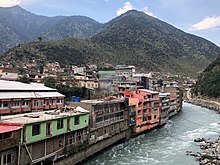
Back تروالية Arabic Torvalia lingvo Esperanto Idioma torwali Spanish زبان توروالی Persian Torwalin kieli Finnish Torwali French तोरवाली भाषा Hindi Bahasa Torwali ID トルワル語 Japanese Bahasa Torwali KGE
| Torwali | |
|---|---|
| توروالی | |
 Torwali written in Perso-Arabic in Nastaliq style. | |
| Region | Swat District |
| Ethnicity | Torwali people |
Native speakers | 130,000 (2020)[1] |
| Arabic script (primarily Nastaliq) | |
| Language codes | |
| ISO 639-3 | trw |
| Glottolog | torw1241 |
| ELP | Torwali |
 Torwali is a minor language of Pakistan which is mainly spoken by Torwali nation of Central Swat District, it is given a space in this map. | |

Torwali (Torwali: توروالی),[2] also known as Bahrain Kohistani,[3] is an Indo-Aryan language spoken by the Torwali people, and concentrated in the Bahrain and Chail areas in the Swat Kohistan region of the Swat District in northern Pakistan.[4][5][6][7] The Torwali language is said to have originated from the pre-Muslim communities of Swat.[8] It is the closest modern Indo-Aryan language still spoken today to Niya, a dialect of Gāndhārī, a Middle Indo-Aryan language spoken in the ancient region of Gandhara.[9][10] Torwali and Gawri languages are collectively classified as "Swat Kohistani".[11]
The words "Kohistan" and Kohistani are generic terms. Kohistan in Persian and in Urdu means as "land of mountains" whereas "Kohistani" refers to 'language spoken in the land mountains" or 'people of the mountains.[12] Joan Baart is the only author who used the term "Bahrain Kohistani" for the Torwali language. Ethnologue, twenty seventh edition suggests Kohistani, Torwalak, Torwalik and Turvali as alterative names for the language while Torwali as an autonym for it.[2]
Torwali is an endangered language: it is characterised as "definitely endangered" by UNESCO's Atlas of Endangered Languages,[13] and as "vulnerable" by the Catalogue of Endangered Languages.[14] There have been efforts to revitalize the language since 2004, and mother tongue community schools have been established by Idara Baraye Taleem-o-Taraqi (Institute for Education and Development) (IBT).[15]
- ^ Torwali at Ethnologue (26th ed., 2023)

- ^ a b Eberhard, David M.; Simons, Gary F.; Fennig, Charles D. (2024). Ethnologue: Languages of the World (27 ed.). Dallas: SIL International.
- ^ Baart, Joan L. G. (1997). The Sounds and Tones of Kalam Kohistani: With Wordlist and Texts. National Institute of Pakistan Studies. p. 1. ISBN 978-969-8023-03-4.
- ^ Kreutzmann, Hermann (2005). "Linguistic diversity in space and time: A survey in the Eastern Hindukush and Karakoram". Himalayan Linguistics. 4. Center for Development Studies, Free University of Berlin: 7.
- ^ Torwali, Zubair (2016). "Reversing Language Loss through an Identity Based Educational Planning: The Case of Torwali language" (PDF). Eurasian Journal of Humanities. 1 (2): 24.
- ^ Biddulph, John (1880). Tribes of the Hindoo Koosh (PDF). Graz, Austria: 1971 edition Akadmeische Druck u Verlagasasntalt. p. 69.
- ^ Barth, Fredrik (1956). Indus and Swat Kohistan: an Ethnographic Survey. Oslo. p. 52.
{{cite book}}: CS1 maint: location missing publisher (link) The Pathans call them, and all other Muhammadans of Indian descent in the Hindu Kush valleys, Kohistanis. - ^ Torwali, Zubair (4 March 2019). "Revitalization of Torwali poetry and music". We Mountains – Regional Website of North Pakistan. IBT. Retrieved 5 March 2019.
- ^ Burrow, T. (1936). "The Dialectical Position of the Niya Prakrit". Bulletin of the School of Oriental Studies, University of London. 8 (2/3): 419–435. ISSN 1356-1898. JSTOR 608051.
... It might be going too far to say that Torwali is the direct lineal descendant of the Niya Prakrit, but there is no doubt that out of all the modern languages it shows the closest resemblance to it. A glance at the map in the Linguistic Survey of India shows that the area at present covered by "Kohistani" is the nearest to that area round Peshawar, where, as stated above, there is most reason to believe was the original home of the Niya Prakrit. That conclusion, which was reached for other reasons, is thus confirmed by the distribution of the modern dialects.
- ^ Salomon, Richard (1998-12-10). Indian Epigraphy: A Guide to the Study of Inscriptions in Sanskrit, Prakrit, and the other Indo-Aryan Languages. Oxford University Press. p. 79. ISBN 978-0-19-535666-3.
- ^ Rensch, Calvin Ross; Decker, Sandra J.; Hallberg, Daniel G. (1992). Languages of Kohistan. Sociolinguistic Survey of Northern Pakistan. Vol. 1. National Institute of Pakistan Studies, Quaid-i-Azam University. p. xiii. ISBN 969-8023-11-9.
- ^ Baart, Joan L. G. (1997). The sounds and tones of Kalam Kohistani: with wordlist and texts. Studies in languages of Northern Pakistan. National Institute of Pakistan Studies, Summer Institute of Linguistics (United Kingdom). Islamabad : United Kingdom: National Institute of Pakistan Studies ; Summer Institute of Linguistics. ISBN 978-969-8023-03-4.
- ^ Torwali, Zubair (2016). "Reversing Language Loss through an Identity Based Educational Planning: The Case of Torwali language" (PDF). Eurasian Journal of Humanities. 1 (2): 24.
- ^ Hammarström, Harald. "Torwali". Glottolog. Retrieved 17 April 2019.
- ^ Liljegren, Henrik (2018). "Supporting and Sustaining Language Vitality in Northern Pakistan". The Routledge Handbook of Language Revitalization. pp. 427–437. doi:10.4324/9781315561271-54. ISBN 978-1-315-56127-1.